About the stimulation of active sales managers
Being entrepreneurs, we understand management as a science. It is well known that science does not consist of only theories but also of problems, enrollments of exercises, methods, examples or – as it is fashion to say - cases.
We believe we can present You with more than a 100 real practical problems, dissected with the above-mentioned methodical care. And we hope that we shall be able to make it not only useful, but also interesting for You.
The structure presented is very close to the structure used in the book of Peter Makovetskiy "BEHOLD THE ROOT" (P. V. Makovetskiy. Look at the root! A collection of problems and questions. 3rd ed – М.: "Science", 1976; 4th ed. – М.: "Science", 1979; 5th ed. – М.: "Science", 1984.)
Each problem is described into three parts А, В, С.
- А – the conditions of the problem.
- В – traditional incorrect answers. In the same way, section B does not only prevent errors but willingness and unwillingness are also hints. This section shows which “visible and well-known truths” do not really exist. By cutting off the wrong directions, it gives a hint of the truth.
- С – it is A STEP TOWARDS THE CORRECT ANSWER. And very often it is also the answer itself. And of course we hope that before reading section C, the Reader will try to solve the problem himself.
Since the problem will be published in bits and parts (and this will stop only either after the all the topics are covered or after the death of the last author), you can write your reviews and notices on the forum www.triz-ri.ru/forum.
© A. Kavtreva, S. Sychev, K. Tkalich, “Sychev and co.” LTD, 2010.
FROM SECTION 1 "ACTIVE SALES"
PROBLEM 1. WHY ARE THE WORDS “GOOD” AND “WEALTHY” NOT SYNONYMES
А. CONDITIONS
How to give a plan of sales to the trading agent, who actively looks for new Clients, when not only the number of Clients is important but also their “significance”, which is not easy to formalize?
It is obvious that a large Client is always better, but what is the point of measure of his size? I would seem that “entering” a large trading chain as a delivery-man is better than - the neighboring small shop, but the small shops are also important (there are many of them). And it is obviously not allowed to behave differently with different Clients: there are no large or small ones – we should attend all of them identically tenderly.
В. TRADITIONAL INCORRECT ANSWERS
Incorrect answer-1. Defining the significance of a Client only through income: the one who buys for a huge sum is a "good client", the one buys for a small sum is also good, but... "he did not take much".
According to the Hamburg reckoning, such an answer shows the absence of strategy in sales. A good company should correctly set up its working system and should not "cut it" at once.
That is why, if we define the significance of a Client through the sum of his average dealings, we should explore a specific idea. A good strategy still involves a linear product (service), different by price, but playing different roles in the whole range. For example, goods with fluid turnover as compared to a low price (or the same standard services reflected "on the flow") are used to increase the number of visits, following which are also sold expensive positions.
Typical examples of different strategies are described in the article "The natural development of the service".
The entrepreneur who is solving the "motivation" task should have "a game plan". The incorrect answer-1 does not involve such a plan, that means it does not involve any segmentation of the market.
Typical EXAMPLE
It is obvious that the Client of a hotel who is paying for a suite is valuable. But the Clients paying for a standard room are also valuable:- They are often on a business-trip and of course, they are settled in an economic class;
- But some of them might come back with their families and shall rent a big expensive room if he likes the service, and of course, if we are not talking about boondocks;
- The flow of business trips leads to a rise in rental deals of conference halls;
- And conferences as a result lead to the hotel being full and increase the income of restaurants etc.;
- Clients give recommendations to their colleagues, partners in business. Some of those who were recommended, will book a suite;
- Clients write reviews on popular sites (see also, for example, www.tripadvisor.ru, http://forum.awd.ru and others.) And this flow of information gradually makes the procedure of booking move to this type of services;
- And finally, there are more Client booking standard rooms – hence the probability for the above-mentioned event to occur increases.
If there were only suites in the hotel, then it would have bankrupted. But if it works correctly with different selected Client flows, the suites are generally full.
С. A STEP TOWARDS THE CORRECT ANSWER
We find the cause for the problem. The Problem occurred since a single-factor system (depending on the amount of deals) is “used” for a multifactorial situation (many different contexts of significant of the Client).
Eliminate this cause. Make the Client typical.
EXAMPLE
A wholesale company "Creative Enthusiasts" delivers goods to very different companies:
- It delivers them to large trading chains,
- It delivers them to different small but numerous shops,
- It delivers them to corporate Customers who buy these goods for their personal use,
- It delivers them to small regional supermarkets
- etc.
At the same time, Customers do business in different ways: some order small amounts, others - large amounts. That is, the values of the "average trades" of different Clients differ greatly. Also, some of the Customer requests a delay in payment, some cannot operate without it, some of them - take the products to the market, and some pay immediately, however, they demand discounts, etc.
STEP 1. Let's formalize all this variety.
For example,
Table 1. Typification

STEP 2. We shall give a grade to each type of Clients. For that we need to:
а) Imagine a situation where each Client of a specific type paid an equal typical frequent sum. Let’s suppose amounting to USD 5 500. (Of course, You have to imagine Your typical deal).
в) We ask ourselves a control question: "Are the Clients in this situation, who are paying equal sums in the first deal, on the same level from the point of view of potential, or not?" Since for example, "a federal chain of supermarkets" (with which we will continue to work in the future), which made an order of USD 5 500 thousand today, most certainly, "is not on the same level" as a one-time Client, who paid the same amount.
с) And if Clients (for the same order) are not on the same level, then in which ratio should they be "interchanged"?
For example,
Table 2. GRADING AND "EXCHANGE RATE"
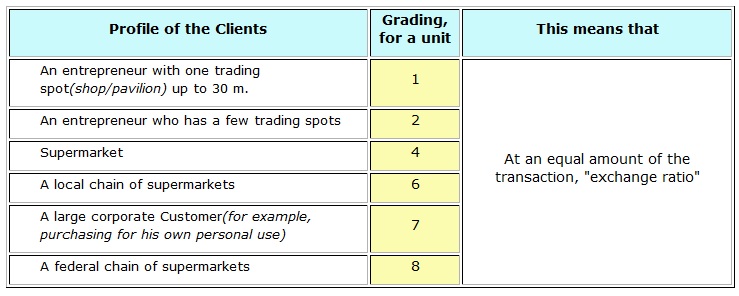
Of course, for Your particular business, You need to make your typification of Clients and specify its "exchange ratios ".
STEP 3. The standard (planned) number of new Clients, which the agent has to attract in a month, will also be described in grades (that is we shall multiply it in "grading").
The sum of the results obtained, is used to calculate the general standard for the number of new Clients (in grades).
Table 3. GRADING, "EXCHANGE RATE" AND STANDARDS
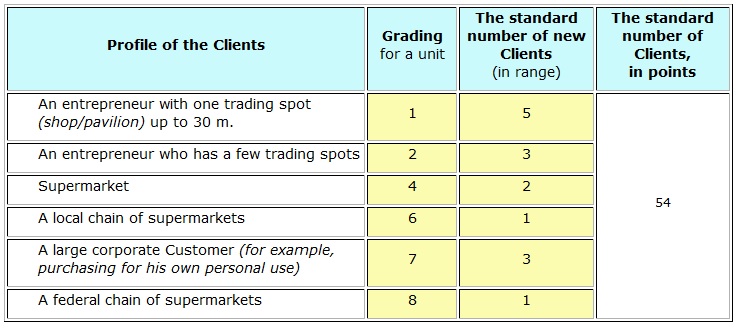
The ratio of the actual output to the standard would show us the effectiveness for new customers.
PROBLEM 2. WHY THE SMALL CAN BE BIG
А. CONDITIONS
How to proceed in stimulating agents who are looking for new customers, if the first transaction is not indicative? Large customers may well make small trial orders. Then an agent in a conventional (for EXAMPLE, "interest") payment system, will receive the first deals with a small reward disproportionally to the effort invested.
В. TRADITIONAL INCORRECT ANSWERS
Incorrect answer-1. Sometimes it is answered as such: "And so what? Let them deal better and let them search more actively for other Clients. If he will work productively, then for the month as a whole he shall get a good salary. After all, he is an agent and it is his duty to convince Clients and increase the amount of orders, "the dog that trots about finds a bone" and "that is why we keep it" – that is exactly his "damn work".
Of course, with all external consistency, this answer is incorrect. And that is why:
а) The main message of the wrong answer is: "let it gather volume, "statistics" shall smoothen the rest, and the more the "statistics", the less the variations".
But if it were as such, would sales have been organized with agents? "A smoothening statistic" will not be possible for only a few dozens of deals a month (not speaking about a lower amount of deals).
There would not have been a problem, would it have been otherwise. And if we are actually talking about more deals, then sales, most certainly have not been properly organized. After all, if we are to service the "flow", why is it required to use agents?
b) Because of such a reasoning "Clients are not considered".
When you are trying to smoothen the situation, you do not consider the deviations. But it would have been far better to answer the following questions:
- Who is that Client?
- Why is he doing that?
- Is it a one-time thing or have there been other similar cases?
- Will there not be regularity if we gather all the "first small deals" for a long period of time?
- Are the "Clients who are sampling" similar in some way?
- Are there any "holes" in our range? Maybe they can explain all this "strangeness"?
- Why do we not ask those Clients who already buy in bulk though they used to buy "in small amount" – since we have already built a relationship with many of them?
To sum up, traditional "drifts" may sometimes hide behind pretty words about statistics.
Incorrect answer-2 sounds as follows: "Let’s wait a few months and consider a few of the next deals".
Of course it is also incorrect. How many months should we wait? How many additional deals should we consider? Of course, we can "come to an agreement" but it is only "theoretical". What shall we do when, for example a bulk order follows two small deals? Should we consider it? And what if a big deal follows three small ones? Ad our agent will surely say that: "I created this bulk order by qualitatively working with this Client!" Should we agree with him? But the same argument will be presented for any number of first deals.
And then this solution will stimulate the reduction of search for new Clients and the agents will focus on the service of already found ones in order to get a large order.
And after some time, the agent becomes less active having increased his personal database: since he already does not have to attract anymore Clients, the current orders "are feeding him just fine".
And this often leads to the incorrect answer-3:
- So, just let him work with “his” Clients. Let him develop them. It is a well-known fact that "20% percent of the Clients bring 80% of the net income" etc.
Unfortunately, this externally rational opinion, in this case is incorrect.
The service and development of "current Clients" is useful, maybe even crucial, but it is not the same work as looking for new Clients. We cannot stop the active search of Clients. More accurately, we cannot solve the personal motivation problem by decreasing/denaturing the search for new Clients.
Let the work with current Clients be fulfilled permanently and qualitatively by other specialists. And we shall talk about how to stimulate them in our next chapters.
С. A STEP TOWARDS THE CORRECT ANSWER
We get incorrect answers when we try to correct the situation without finding out the cause (the root) of the problem beforehand. What is the purpose of "changing the consequences"? We correct one – another crops up.
Let’s find the cause. The reason of the problem is that: the award does not correspond to the efforts. In this case, it is unproportionally small.Does this hint help? If it still does not help we shall consider the reverse problem.
PROBLEM 3. WHY IS BIG SOMETIMES SMALL
А. CONDITIONS
What should be done if we found only a few Clients for the month and on top of that, any Client can suddenly pass a large order (it would not be proper to include that in our plan)? That is, to wrongly set up the target income twice or even 20 times(!) is very easy in such a case. It is not acceptable to pay a salary which varies largely from one month to another, is it?
В. TRADITIONAL INCORRECT ANSWERS
Incorrect answer 1. Very often an incorrect answer similar to one of those for problem number 2 is given for this question: "Do not consider the number of Clients. In some month the agent will get "excess" and in another he shall not get enough, and as a whole it will seem "as if, fair". Of course, this answer is frivolous and incorrect.
Here we shall not only repeat the arguments proposed earlier (please refer to problem 2), but also ask you to reread the conditions of the problem attentively: the number of deals is insignificant.
You can, of course, not solve this problem, and put a new one: "How to increase the number of new customers to such values at which the current problem will lose its relevance?" But such a wording is not at all similar to the proposal to avoid considering the number of Clients.
Incorrect answer 2. It is sometimes advised in the same frivolous manner to avoid the term "new Client". This is explained in the following way:
- If the total number of transactions (both old and new) is large, then the variations decrease: whether there were 2 new Clients this month or 5 - the difference in the number of new clients "dissolves" in the total general income. – What interests us is the "end result", in order for the "Client database to grow" – usually we reinforce the erroneous argument with a slogan.
The main disadvantage (which makes this solution unfit for use) is the following: namely, when the Client database becomes sufficiently large, in a certain way, the number of new Clients becomes unacceptably small. And motivation disappears together with variations. Why bother looking for new Clients if for a month (in relation to the general number and income from all the current deals) there are only a few new ones, this clause has not been mentioned, Clients are all different, and the increase in income will not be proportional to efforts.
It is much easier to write an invoice on the SUM, than "bother" with new Clients. And of course, we will have to tackle the problems mentioned earlier.
Incorrect answer 3 deals with the introduction of a regression scale: The more the Client has paid, the less the award for the deal.
The demotivation force of this "method" is only equal to the decrease in rates in fulfilling the target during the social realism period.
Furthermore, this "method" causes lies and the Clients becomes more alarmed about the complications in the business processes, for the Client as well as for the Company: for example, the agent may begin to ask the Client to break the deal into small parts etc.
С. A STEP TOWARDS THE CORRECT ANSWER
The cause of the problem: A (large) change in the volume of deals is not linearly proportional to the effort of the agent. Award does not correspond to efforts. By the way, PROBLEM 1 and PROBLEM 2 are separated here for convenient presentation – they have the same causes.In order to get rid of the cause of the problem, we have to remove the linear relationship between the award amount and the volume of the deal in the formula of motivation.
That is why, we introduce a range: we give a "linear" range of incomes for the first deal with each new Client and evaluate the corresponding "amounts".
In order to achieve that:
STEP 1. We take a real maximum one-time deal. Let’s suppose it is USD 14 000. Then let the range “higher than USD 14 000” be the last line in the table of ranges (see table 4).
STEP 2. Let’s suppose that somebody proposes us to change the "money to possibilities": "I give You a one-time Client for 14 000 dollars, but for one-time only (for one deal). And in exchange, You give me one with the possibility for many deals irrespective of the sum of the deal now".
Let’s suppose that a company (in the example considered), mentally gives away a "supermarket" for an "immediate half-million". (If you consider this to be "too much", then simply answer to the question: "Which type of Client do You mentally give away for a one-time large deal?").
This "supermarket" has a value of = 4. See the example to problem 1.This means that, 1 mark falls into the range "around" USD 3 500.
And let the largest of real first deals fall into the second last range in order to have the motivation to overcome this borderline.
Table 4. THE RANGES OF DEALS
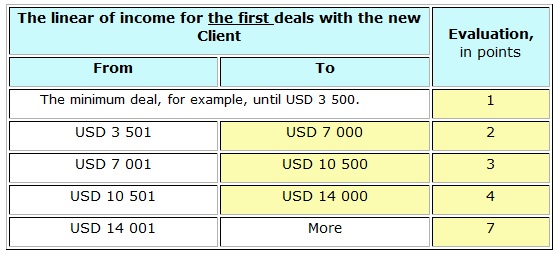
The last line can contain "jumps" (for example, immediately to 7 points): the event is rare and a record. Let it contain a bonus.
Of course, this table can be differentiated into a more detailed one. For example in the following way:
Table 5. THE RANGE OF DEALS (with the least step)
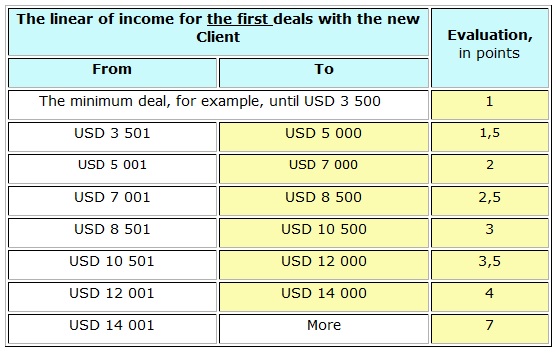
STEP 3. We add a field with standard (planned) number of deals for each range and as a whole.
By calculating the product of the marks of each range to the standard number of deals in that range and the sum of the product results, we get the standard for income (in marks).
Table 6. THE RANGE OF DEALS AND THE STANDARDS
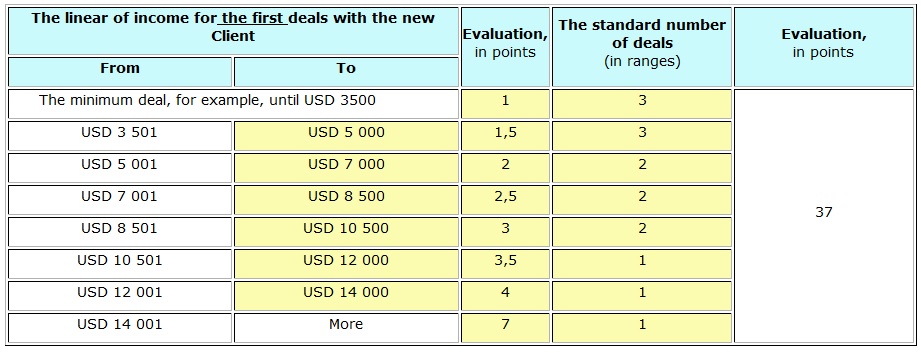
If we now take the correlation between the factual income and the standard, then we shall deduce the efficiency on income.
Since we set up a standard taking into consideration the typical first deals (i.e. we do not link award to the size of the deal, but we differentiate the award into ranges – see table 6), the problem about disproportionality in a specific deal is solved.
The presence of ranges and the absence of a linear correlation between the evaluation and the amount of money allow us to smoothen the variations even for statistically low amount of deals (for example, a dozen or less). This is not possible when measuring the results money-wise or with the number of deals (unit). That was actually the PROBLEM. Now the stimulation is preserved, but the cause for problems 2 and 3 is eliminated.
PROBLEM 4. HOW TO CORRECTLY POSTPONE
А. CONDITIONS
What is to be done in those situations when it is important that the agent not only aims at getting a big revenue from a newly found Client but also tries to sign a contract for more favorable terms for the company on deferred payment.
Because, signing a contract with a delay of, for example, 30 days and 90 days – is not the same thing. Of course, the company has standard measures to prevent delay, but the agent tries new tricks to persuade the management to deviate from the standard and to "take it easy", since "the Client wants to try" etc.
But the company, on the contrary, thinks that: "The first time – with prepayment".
В. TRADITIONAL INCORRECT ANSWERS
Incorrect answer involves the effort to fight against the rational egoism of the employee, to foster a "team spirit', to introduce bonuses "from the net financial results of the whole company" (very often with the division of bonus part of the salary into "your" and "the general (firm’s)"), in order for "the company to be loved" etc.The disadvantages of stimulation "from general affairs" are well known. What is general – is not mine. The contribution of the employee dissolves into the "general efficiency", which depends on a wide range of factors, and the employee cannot affect many of them. "The general efficiency", is moreover, often represented by other units of measurement than the work efficiency of the employee, and consequently the employee does not see the relation between his work and his award.
A less noticeable disadvantage of "general affairs" is presented in the forum in the discussion section Team coefficient.
С. A STEP TOWARDS THE CORRECT ANSWER
Let’s find the cause of the problem. It is easier for the agent to get a deal with a long delay. In order to get a deal with only a short delay, he needs to spend more efforts, but the sum of the deal is the same.
This means that the cause of the problem is that: the agent does receive additional award for a short delay. The criterion "sum of deals" is not enough.
Let’s eliminate this cause.
Table 7. EVALUATION OF DELAY
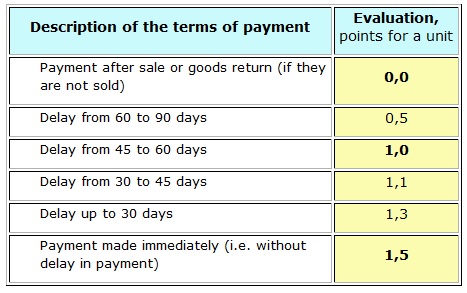
In the table:
- Are given the ranges of the allowed delays;
- An evaluation of each range is made (the number of days delayed) in marks.
The marks are attributed using the following principle:а) The worst situation (for example, when the goods are simply taken for sale and/or the threshold beyond which there is only failure) is denoted with 0.b) The level of delay which is acceptable in that market is denoted with 1 point (i.e. it is so frequent that it is inevitable to consider).c) For an immediate payment (without delay) we denote the maximum number of points (as in the example 1,5)
d) Between the critical points are given the intermediate points. (You can set the level of differentiation (the size of the term) as you deem right.)
We add the field for the standard (planned) number of delays for each range and as a whole.
By finding the product of the evaluates of the range to the standard number of deals (referring to the delay) in that range and by adding the results thus obtained, we calculate the general standard (in points).
Table 8. EVALUATION OF DELAY AND STANDARDS
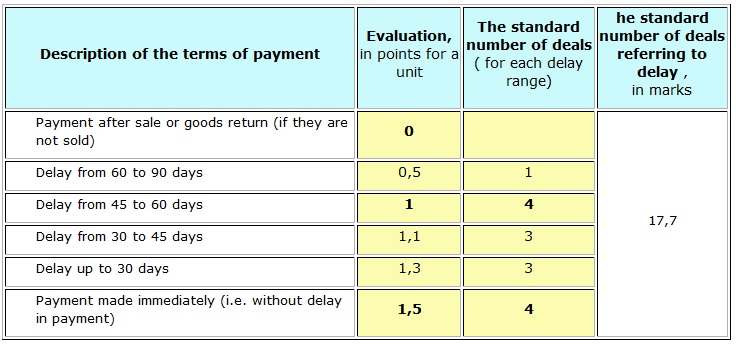
The correlation between the factual delay (in marks) and their standard values, show us the efficiency of salary received.
The following question might crop up: "Why did we set up a margin for delay as a range "from 0 to 1,5", when the margin for "evaluation of types of Clients" and the "number of deals" are different.
In other words: "Why was the maximum value chosen as 1,5, and not, let’s say 10?"
The cause of this is the following: The agents should not be stimulated to focus only on a large number of deals but "on small amounts, and without delay". Because, if the deal without delay 'would weigh" for example, 10 points, then such a roll would be formed.
Our aim is to increase the number of profitable transactions with deferred payment, which are found within appropriate ranges and not the total block of delays. For example, we shall not refuse a Federal network which is buying for a large sum, a deferred payment for 45 or 60 days.
That is why, the significance of delays in relation to other indicators is reduced.
WE SHALL COLLECT 4 CHALLENGES IN ONE SALARY. METHODOLOGICAL SUMMARY
1. The incorrect answers illustrated above are related to an error in thinking and include the following:
Instead of knowing and eliminating the causes of the problems, various "compensatory and fitting ideas" are proposed. Of course none will work. For example, if the cause of the problem is that there is no linear relation between the efforts of the agent and the value of the deal, then it is futile to "choose coefficients' which would 'smoothen the situation" or raise "team spirit" etc.
If the PROBLEM is comprised of several factors, then it ignoring these factors and looking for "one", "integral" or other indicator, does not make sense.
2. In all the 4 cases, we made similar transformations (even if it was for different objects: "number of Clients", "income", "deferred payment", it could be something else): we set up ranges, and in doing so, we moved from a linear system (which affected the problem) to a discrete one.
3. Now let’s gather all the criteria implemented in items "C" of each problem together. Since all these problems are linked to one position: "an agent making active sales". We implement the model of evaluation of his work which would cover all the considered cases.
These are our reference notes. We had already filled them:
Reference 1"CLIENTS"
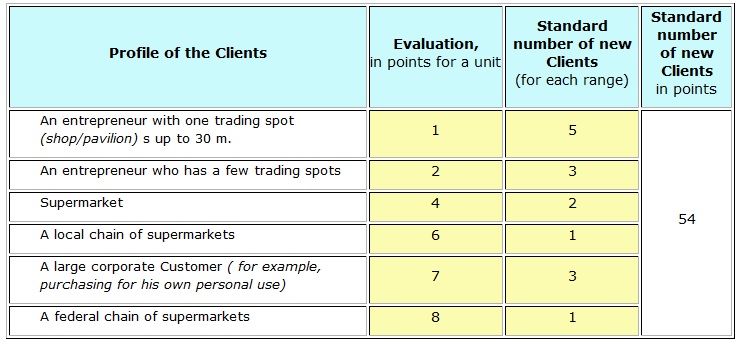
Reference 2 "INCOME"
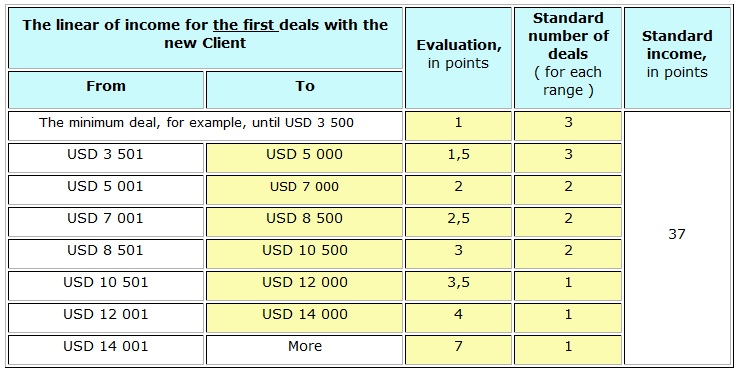
Reference 3 "CONDITIONS"
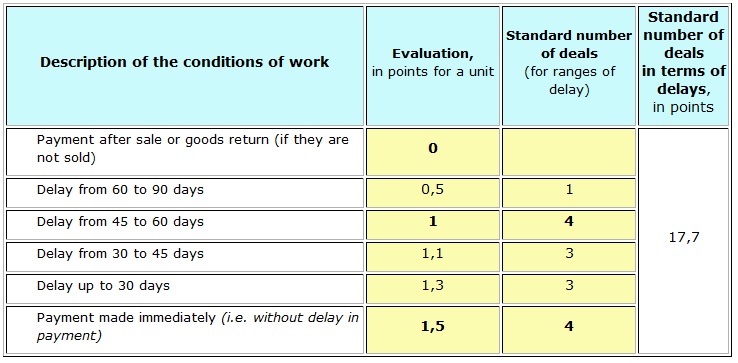
Let’s suppose that our agent has struck 14 deals with new Clients for a month. We write down the result in the table below "factual sales":
Table 9. FACTUAL SALES TO NEW CLIENTS (EXAMPLE)
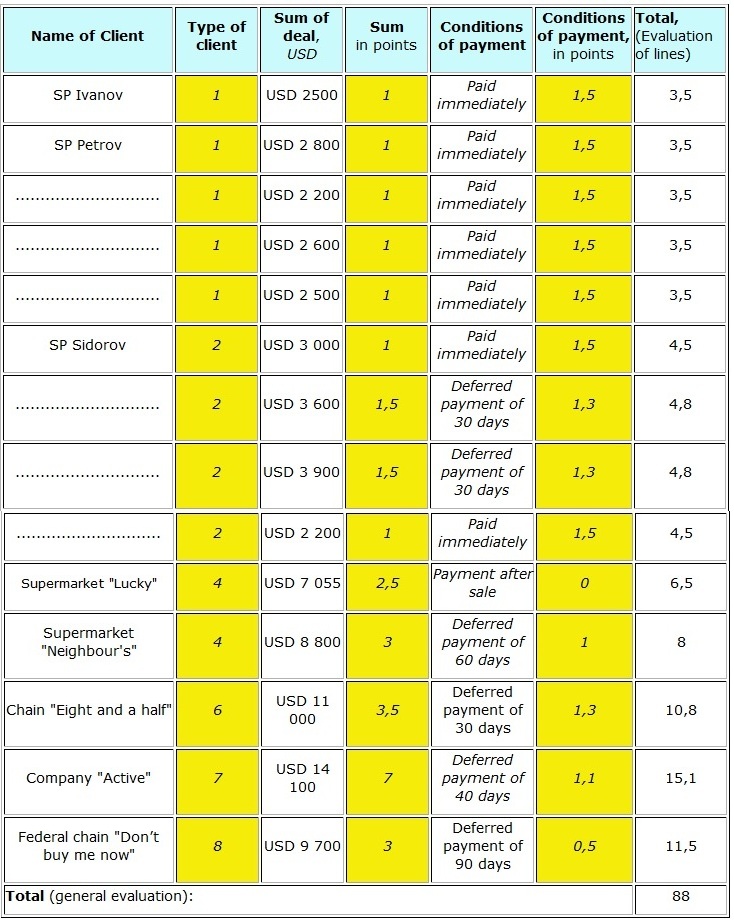
In such a way, he totalized 88 points and his efficiency is 81%.
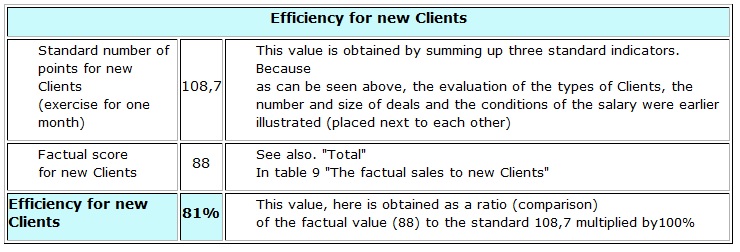
SOURCE OF EXAMPLES:
The model was based on the statistics and long-term work of the authors on the development of sales departments:
- In wholesale companies of different profiles;
- In companies dealing with equipment;
- In companies providing services to corporate Clients;
- In companies delivering dental materials;
- In companies dealing in the sales of souvenirs made of expensive materials and jewelries;
- ... (we can continue the list)
You can buy a ready-made electronic model of salary for agents (it is also often known as managers of active sales) – so that the problems listed above did not affect You - here: www.triz-ri.ru/eng/active











